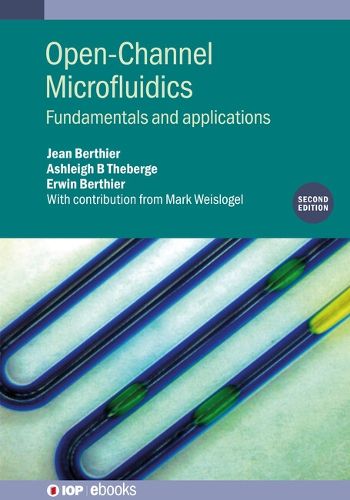Readings Newsletter
Become a Readings Member to make your shopping experience even easier.
Sign in or sign up for free!
You’re not far away from qualifying for FREE standard shipping within Australia
You’ve qualified for FREE standard shipping within Australia
The cart is loading…






This title is printed to order. This book may have been self-published. If so, we cannot guarantee the quality of the content. In the main most books will have gone through the editing process however some may not. We therefore suggest that you be aware of this before ordering this book. If in doubt check either the author or publisher’s details as we are unable to accept any returns unless they are faulty. Please contact us if you have any questions.
The development of open microfluidics is relatively recent and is an emerging sub-domain of capillarity, with many applications. This second edition research text presents the state-of-the-art theory of open microfluidics, including inertial and viscous regimes, uniform channels and converging/diverging channels, networks, bypasses and valves. It recalls the conditions for the establishment of an open microflow, and presents the dynamics of open microflows, guided by different solid structures such as fibres and threads, with a focus on open-channels. The book shows how the Lucas-Washburn law must be adapted to describe the dynamics of open microflows. It also demonstrates how surface energies, fluid properties, and solid geometry are combined to design open-microfluidic systems and devices that are used in numerous domains. Additionally, the book shows how biomimetics has inspired new advanced open microfluidic designs.
Key Features
Presents the state of the art of the theory of open microfluidics, including inertial and viscous regimes, uniform channels and converging/diverging channels, networks, bypasses and valves Covers the latest applications of open microfluidics in the fields of engineering, biotechnology, biology, chemistry, medicine, materials, biochemistry, and spacecraft Expands the content on the theoretical approach for uniform and arbitrary cross-section channels from one chapter to two chapters Includes a new chapter on advanced geometries for open microfluidics
$9.00 standard shipping within Australia
FREE standard shipping within Australia for orders over $100.00
Express & International shipping calculated at checkout
This title is printed to order. This book may have been self-published. If so, we cannot guarantee the quality of the content. In the main most books will have gone through the editing process however some may not. We therefore suggest that you be aware of this before ordering this book. If in doubt check either the author or publisher’s details as we are unable to accept any returns unless they are faulty. Please contact us if you have any questions.
The development of open microfluidics is relatively recent and is an emerging sub-domain of capillarity, with many applications. This second edition research text presents the state-of-the-art theory of open microfluidics, including inertial and viscous regimes, uniform channels and converging/diverging channels, networks, bypasses and valves. It recalls the conditions for the establishment of an open microflow, and presents the dynamics of open microflows, guided by different solid structures such as fibres and threads, with a focus on open-channels. The book shows how the Lucas-Washburn law must be adapted to describe the dynamics of open microflows. It also demonstrates how surface energies, fluid properties, and solid geometry are combined to design open-microfluidic systems and devices that are used in numerous domains. Additionally, the book shows how biomimetics has inspired new advanced open microfluidic designs.
Key Features
Presents the state of the art of the theory of open microfluidics, including inertial and viscous regimes, uniform channels and converging/diverging channels, networks, bypasses and valves Covers the latest applications of open microfluidics in the fields of engineering, biotechnology, biology, chemistry, medicine, materials, biochemistry, and spacecraft Expands the content on the theoretical approach for uniform and arbitrary cross-section channels from one chapter to two chapters Includes a new chapter on advanced geometries for open microfluidics